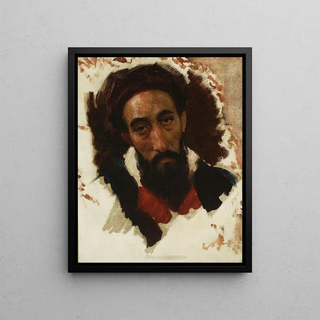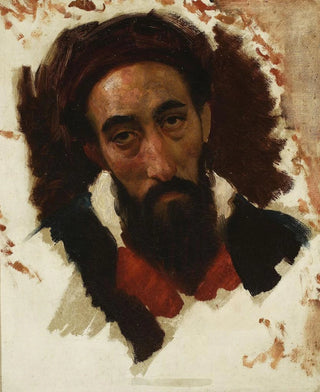Art print | Study of a male head - Horace Vernet


View from behind

Frame (optional)
The artwork "Study of a Male Head" by Horace Vernet presents itself as a window into the intimacy of a gaze, an exploration of human psychology through the lens of portraiture. This study, which demonstrates remarkable technical mastery, invites the viewer to delve into a universe where every detail, every shadow, every light seems to tell a story. Vernet, known for his battle scenes and portraits, offers here a more personal reflection, a study that transcends mere visual representation to touch on the very essence of human nature. Contemplating this piece, one feels an immediate connection with the subject, an invitation to question one's identity, thoughts, and emotions.
Style and uniqueness of the artwork
The originality of "Study of a Male Head" lies in the expressive treatment of the face, which captures attention through its liveliness and striking realism. Vernet skillfully uses light to shape the features of the face, creating a depth that brings the character to life. The delicate nuances of the skin, the reflections in the eyes, and the precision of the details are all elements that testify to his ability to capture the essence of the human figure. This artwork also stands out for its psychological approach, where the model's gaze seems to question the viewer, establishing a silent dialogue between the artist, the subject, and the observer. Vernet manages to infuse a palpable humanity into his work, making the viewer witness raw and authentic emotion.
The artist and his influence
Horace Vernet, born in 1789, is an emblematic figure of the 19th century, whose work has left a mark on the history of French art. Son of the painter Claude Vernet, he was quickly immersed in an artistic environment that shaped his style. Influenced by the great masters of the past, Vernet developed a technique that combines realism and romanticism, capturing scenes of dramatic intensity. His ability to portray characters with such psychological depth has left an indelible imprint on his contemporaries and subsequent generations. Vernet is not only a painter but also a storyteller, capable of narrating stories through his works.

Matte finish

View from behind

Frame (optional)
The artwork "Study of a Male Head" by Horace Vernet presents itself as a window into the intimacy of a gaze, an exploration of human psychology through the lens of portraiture. This study, which demonstrates remarkable technical mastery, invites the viewer to delve into a universe where every detail, every shadow, every light seems to tell a story. Vernet, known for his battle scenes and portraits, offers here a more personal reflection, a study that transcends mere visual representation to touch on the very essence of human nature. Contemplating this piece, one feels an immediate connection with the subject, an invitation to question one's identity, thoughts, and emotions.
Style and uniqueness of the artwork
The originality of "Study of a Male Head" lies in the expressive treatment of the face, which captures attention through its liveliness and striking realism. Vernet skillfully uses light to shape the features of the face, creating a depth that brings the character to life. The delicate nuances of the skin, the reflections in the eyes, and the precision of the details are all elements that testify to his ability to capture the essence of the human figure. This artwork also stands out for its psychological approach, where the model's gaze seems to question the viewer, establishing a silent dialogue between the artist, the subject, and the observer. Vernet manages to infuse a palpable humanity into his work, making the viewer witness raw and authentic emotion.
The artist and his influence
Horace Vernet, born in 1789, is an emblematic figure of the 19th century, whose work has left a mark on the history of French art. Son of the painter Claude Vernet, he was quickly immersed in an artistic environment that shaped his style. Influenced by the great masters of the past, Vernet developed a technique that combines realism and romanticism, capturing scenes of dramatic intensity. His ability to portray characters with such psychological depth has left an indelible imprint on his contemporaries and subsequent generations. Vernet is not only a painter but also a storyteller, capable of narrating stories through his works.






